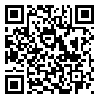Volume 8, Issue 1 (2022)
IEM 2022, 8(1): 17-26 |
Back to browse issues page
Download citation:
BibTeX | RIS | EndNote | Medlars | ProCite | Reference Manager | RefWorks
Send citation to:



BibTeX | RIS | EndNote | Medlars | ProCite | Reference Manager | RefWorks
Send citation to:
Nasiri-Jahrodi A, Shams-Ghahfarokhi M, Razzaghi Abyaneh M. Effects of Eugenol-Loaded Chitosan Biopolymer Nanoparticles on CYP51A and CYP51B Expression in Aspergillus fumigatus. IEM 2022; 8 (1) :17-26
URL: http://iem.modares.ac.ir/article-4-55617-en.html
URL: http://iem.modares.ac.ir/article-4-55617-en.html
1- Department of Mycology, Faculty of Medical Sciences, Tarbiat Modares University, Tehran 14115-331, Iran
2- Department of Mycology, Faculty of Medical Sciences, Tarbiat Modares University, Tehran 14115-331, Iran , shamsm@modares.ac.ir
3- Department of Mycology, Pasteur Institute of Iran, Tehran 13164, Iran
2- Department of Mycology, Faculty of Medical Sciences, Tarbiat Modares University, Tehran 14115-331, Iran , shamsm@modares.ac.ir
3- Department of Mycology, Pasteur Institute of Iran, Tehran 13164, Iran
Abstract: (1081 Views)
Backgrounds: Aspergillus fumigatus is a pathogen responsible for invasive aspergillosis and the main leading cause of death in immunosuppressed individuals. The present study aimed to evaluate the impact of eugenol-loaded chitosan nanoparticles on the expression of CYP51a and CYP51b, two well-known genes responsible for triazole drug resistance in A. fumigatus.
Materials & Methods: The minimum inhibitory concentration (MIC) of eugenol-loaded chitosan nanoparticles, chitosan, eugenol, and itraconazole was determined based on the Clinical and Laboratory Standards Institute M38-E3 method at concentrations of 4.6-2400, 11.7-12000, 2-2048, and 1-256 μg/mL, respectively. The expression of CYP51A and CYP51B was evaluated in A. fumigatus exposed to 0.5, 1, and 2× of MIC concentration of NPs and itraconazole using the real-time polymerase chain reaction.
Findings: The obtained results showed that eugenol-loaded chitosan nanoparticles sucessfully reduced A. fumigatus fungal growth at 300 μg/mL concentration. MIC of chitosan, eugenol, and itraconazole was measured to be 6000, 256, and 4 μg/mL, respectively. The results of real-time PCR also revealed that eugenol-loaded chitosan nanoparticles increased the expression of both CYP51A and CYP51B in a dose-dependent manner. The expression of fungal CYP51A and CYP51B at mRNA level was significantly increased 1.26, 1.93, and 3.1-fold as well as 1.2, 2.1, and 2.4-fold at concentrations of 150, 300, and 600 μg/mL, respectively (p<.05). However, it seems that the prepared nanoparticles had a lower impact on the expression of these genes compared to itraconazole.
Conclusion: Overall, these findings suggest that the treatment of A. fumigatus with eugenol-chitosan nanoparticles could increase the expression of the CYP51 gene, suggesting the anti-fungal property of these nanoparticles.
Materials & Methods: The minimum inhibitory concentration (MIC) of eugenol-loaded chitosan nanoparticles, chitosan, eugenol, and itraconazole was determined based on the Clinical and Laboratory Standards Institute M38-E3 method at concentrations of 4.6-2400, 11.7-12000, 2-2048, and 1-256 μg/mL, respectively. The expression of CYP51A and CYP51B was evaluated in A. fumigatus exposed to 0.5, 1, and 2× of MIC concentration of NPs and itraconazole using the real-time polymerase chain reaction.
Findings: The obtained results showed that eugenol-loaded chitosan nanoparticles sucessfully reduced A. fumigatus fungal growth at 300 μg/mL concentration. MIC of chitosan, eugenol, and itraconazole was measured to be 6000, 256, and 4 μg/mL, respectively. The results of real-time PCR also revealed that eugenol-loaded chitosan nanoparticles increased the expression of both CYP51A and CYP51B in a dose-dependent manner. The expression of fungal CYP51A and CYP51B at mRNA level was significantly increased 1.26, 1.93, and 3.1-fold as well as 1.2, 2.1, and 2.4-fold at concentrations of 150, 300, and 600 μg/mL, respectively (p<.05). However, it seems that the prepared nanoparticles had a lower impact on the expression of these genes compared to itraconazole.
Conclusion: Overall, these findings suggest that the treatment of A. fumigatus with eugenol-chitosan nanoparticles could increase the expression of the CYP51 gene, suggesting the anti-fungal property of these nanoparticles.
Keywords: Eugenol-loaded chitosan nanoparticle, Aspergillus fumigatus, CYP51A, CYP51B, Gene expression.
Article Type: Original Research |
Subject:
Mycology
Received: 2021/09/14 | Accepted: 2021/10/29 | Published: 2022/02/21
Received: 2021/09/14 | Accepted: 2021/10/29 | Published: 2022/02/21
Send email to the article author
| Rights and permissions | |
 |
This work is licensed under a Creative Commons Attribution-NonCommercial 4.0 International License. |









